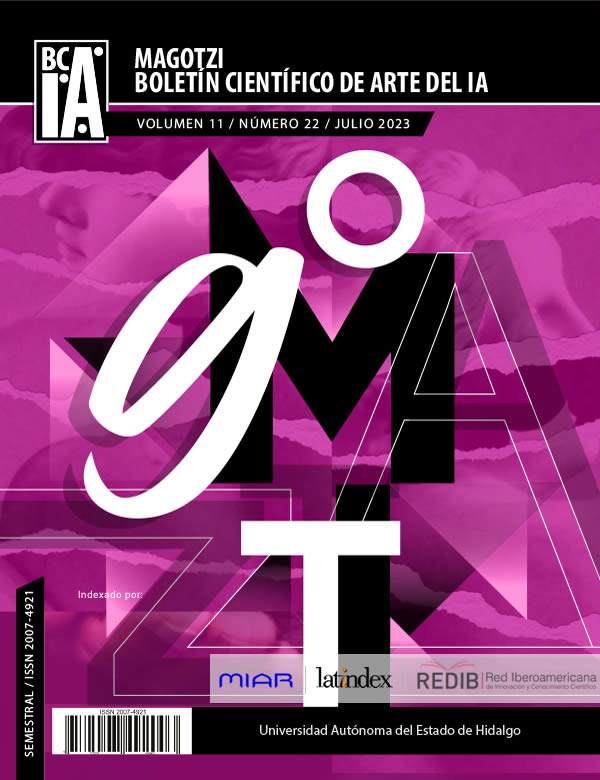Dance and Human-AI Kinaesthetic co-creativity
Abstract
Human-machine interaction in dance is not a new phenomenon, however, the evolution of Artificial Intelligence (AI) in recent years allows new scenarios where novel methods of creative collaboration between human and artificial intelligence are proposed. From an interdisciplinary approach, this article provides an analysis of different software for choreographic creation and synthesises the findings from the creative collaboration between the author and an AI dancer, which were presented at the Leverhulme Centre for the Future of Intelligence at the University of Cambridge (UK). The author concludes that in order to co-create dance with an AI, it is not enough to simply use it, but it must enable an experience in which the human and machine can be exposed to a mutual influence that is not limited to logical reasoning, but is based on kinaesthetic intuition.
Downloads
References
Bandura A. (2001) Social cognitive theory: an agentic perspective [Teoría cognitiva social: una perspectiva agéntica]. Annu Rev Psychol. (52), 1-26. DOI: 10.1146/annurev.psych.52.1.1. PMID: 11148297.
Berman, A. y Valencia, J. (2014). Kinetic Dialogues: Enhancing creativity in dance [Diálogos kinéticos: potenciando la creatividad en la danza]. MoCo 15. DOI: http://dx.doi.org/10.1145/2790994.2791018
Burns et al. (2021) Considering Co-Creation [Plantearse la co-creación]. Arts Council UK. https://www.artscouncil.org.uk/sites/default/files/download-file/ConsideringCo-Creation_1.pdf (Disponible en: 31 May 2022).
Csordas, T. (1990) Embodiment as a Paradigm for Anthropology [La encarnación como paradigma en la Antropología]. Ethos, 18(1), 5-47. https://bit.ly/3wW8yP0
Csordas, T. (1993) Somatic modes of attention [Formas somáticas de atención]. Cultural Anthropology, 8(2) 135-156. http://www.jstor.org/stable/656467
Crnkovic-Friis, L and Crnkovic-Friis, L. (2016) Generative Choreography using Deep Learning [Coreografía generativa mediante aprendizaje profundo]. 7th International Conference on Computational Creativity, ICCC2016. https://arxiv.org/pdf/1605.06921.pdf
Emirbayer, M. and Mische, A. (1998) What Is Agency? [¿Qué es agencia]. American Journal of Sociology , 103, 4, 962-1023. The University of Chicago Press. Recuperado de: https://www.jstor.org/stable/10.1086/231294
Downie, M. & Rothwell, N. (2013). Becoming [Convirtiéndose]. OpenEndedGroup. http://openendedgroup.com/artworks/becoming.html
Downie et al. (2012). Sketching by Programming in the Choreographic Language Agent [Creación de bocetos mediante programación con el Agente de Lenguaje Coreográfico]. PPIG: London Metropolitan University.
Grinberg-Zylberbaum, J. (1988). Psicofisiología del poder. Instituto Nacional para el Estudio de la Conciencia. 1era edición. Ciudad de México.
Houseman, M (2006) Relationality [Relacionalidad], en J. Kreinath, J. Snoek and M. Stausberg (eds.) Theorizing Rituals. Issues, Topics, Approaches, Concepts. (pP. 413-428). Leiden: Brill,
Knappett, C. and Malafouris, L. (2008) Material and Nonhuman Agency: An Introduction [Agencia material y no humana: una introducción] en C. Knappett and L. Malafouris (eds.) Material Agency: Towards a Non-Anthropocentric Approach (pp. 9-19).
Latour (2005) Reassembling the Social: An Introduction to Actor-Network-Theory [Reensamblando lo social: Introducción a la teoría del actor-red]. 1era Edición. Nueva York: Oxford University Press.
Law, J. y Hassard, J. (1999) Actor Network Theory and After [Teoría del Actor-Red y más allá]. 1era Edición. Oxford: Blackwell Publishers.
Laughlin, C. (1997) The Evolution of Cyborg Consciousness [La evolución de la consciencia ciborg]. Anthropology of Consciousness 8(4), 144-15.
Lee, G, Dumit J, Williams, S. (1995). Cyborg Anthropology [Antropología ciborg]. Cultural Anthropology: Anthropologies of the Body 10(2), 264-269. American Anthropological Association. Available at: https://www.jstor.org/stable/656336 (accessed 23 March 2022)
Leach, J., & Delahunta, S. (2017). Dance Becoming Knowledge: Designing a Digital “Body” [La danza se convierte en conocimiento: Diseñando un "cuerpo" digital]. Leonardo 50(5), 461-467. https://www.muse.jhu.edu/article/670953
Leverhulme Centre for the Future of Intelligence (2022). Human-AI collaborative dance [Danza colaborativa Humano-IA]. Events. http://lcfi.ac.uk/news-and-events/news/2022/sep/6/human-ai-collaborative-dance/
Marín Bucio D.A. (2022) Embodying the artificial: Human/AI Co-creation of dance [Encarnando lo artificial: Co-creación de danza Humano-IA]. Choreomundus Consortium. Universidad de Roehampton, Londres.
Marín, Wallace, 6A9 (2022) Dancing Embryo [Embrión Danzante]. Diego Marín Creative Studios. https://diegomarin.art/portfolio/dancing-embryo/
Merleau-Ponty, M. (1945) Phenomenology of Perception [Fenomenología de la percepción]. Edición 2012. London: Routledge.
Varela et al (2006) The embodied mind: Cognitive Science and Human Experience [La mente encarnada: ciencias cognitivas y experiencia humana]. Massachusetts: Massachusetts Institute of Technology.
Wallace B. [Benedikte Wallace]. (19 de agosto de 2020). AI learning to dance [IA aprendiendo a bailar]. https://www.youtube.com/watch?v=YJyo_yobOOs
Copyright (c) 2023 Diego Antonio Marín Bucio

This work is licensed under a Creative Commons Attribution-NonCommercial-NoDerivatives 4.0 International License.












